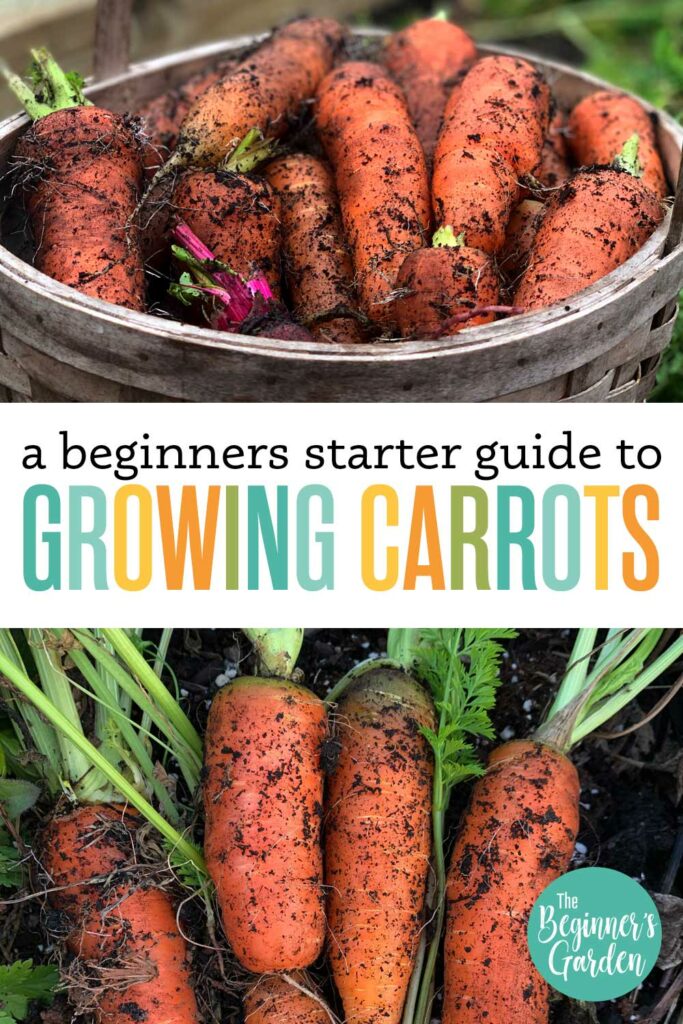How to Grow Carrots: Beginners Starter Guide
Starting a garden this year but don’t know where to begin? Have you had issues in the past with trying to grow carrots? Try these tips to learn how to grow carrots successfully!
When Should Carrots be Grown?
Carrots are a cool weather crop, they can be grown in both spring and fall. They can tolerate frosts (which can happen under 40 degrees F) and plants at all stages can take a freeze (anything at or slightly below 32 degrees). That’s why they are ideal for spring and fall gardens.
Carrots do not like to grow in heat. Some types will begin to bolt when the temperature consistently stays above 90 degrees. The thing to watch for when they begin to bolt is the size of the greens above the ground. Normally the greens stay at around 12 inches tall. When the carrot begins to bolt, a central stalk grows taller than the rest of the greens. Learn more about bolting here.

Even if your carrots don’t bolt in heat, bear in mind that the hotter the temperature is outside, the sharper the flavor of the carrot is. It won’t be as sweet as when grown in cooler weather. That’s why fall and winter carrots are known to be the most flavorful.
Where Should You Plant Carrots?
Rich, loose soil. Carrots like very loose soil to grow in. A raised bed with added compost for extra nutrients is always a good place. While I’ve never fertilized my carrots, adding in compost is usually a great benefit.
Full sun. They do like to have at least 6 hours of sun per day. I have not found that shade helps to keep them from bolting or helps them to grow better. Carrots can also be ground in ground beds, containers or in a GreenStalk Vertical Planter. (use my affiliate code JILL10 for $10 off off your purchase of $75+)
When Should You Plant?
Carrots should be planted 4-6 weeks before your average last frost date in the spring or as soon as the soil is workable. My preferred method is to rough up the soil and water the soil thoroughly. I create a shallow furrow with my hand and add in the seeds covering them only slightly with soil. A gentle spray keeps the soil moist but is not disruptive to the delicate seedlings. I will add a floating row cover on top to keep in the moisture.
TIP: Carrot seeds like to stay very moist until they germinate. Tiny seedlings also benefit from moist soil so it is important to keep the soil wet until they are established. I like to add some sort of cover over my newly sown seeds and wet it down to make sure the soil stays wet, especially when planting in late summer for a fall harvest.
Here’s a look at how I plant carrots:
Growing and Harvesting Tips
The great part about growing carrots is that once the seedlings emerge, the hardest part is over! But, here are a few suggestions on how to keep them growing strong all the way to harvest.
- Carrots should be thinned to one every 2-3 inches; this is very important if you want large carrots. (Here’s how to do it.)
- You can always succession sow them for longer harvests (plant every couple of weeks so the new crops will mature at different times).
- Mulch the plants once established (this will help regulate moisture and cut back on weeding).
- Make sure to look at the days to maturity of the variety you are growing; this will help determine when to harvest.
- You can also move the soil around the top of the carrot to judge the size (this can be misleading though, so always dig and test one carrot first.)
- Unless the soil is very loose, you should use a spade to loosen them out of the ground; we’ve all tried to pull carrots by the tops, only to have the tops snap off with the root remaining underground).
- Remove the tops immediately after harvest. Keeping them on will pull moisture from the root and lead to soft roots.
Varieties to Grow
The best beginner varieties of carrots I have found to grow are Danvers 126 and New Kuroda. You can have fun with the types and grow different colors of carrots such as red, yellow and purple. Just make sure you are keeping your expectations in line as sometimes those can be challenging.
For more tips on avoiding mistakes in growing carrots, read further: Carrots: What Can Go Wrong?
If you want to learn more beginner gardening tips, you can check out The Beginners Garden Podcast wherever you listen to podcasts.
Do you get overwhelmed with garden planning?

Subscribe here for my best tips to plan your garden in just 7 days -- all for FREE.
Plus, I'll send you my "In the Garden E-mail" on Fridays, periodic updates on garden resources relevant to you, and you'll receive access to my entire bank of free garden downloads!
You are also agreeing to our privacy policy.


have you grown carrots in a grow bag?
I have not, but it can be done.